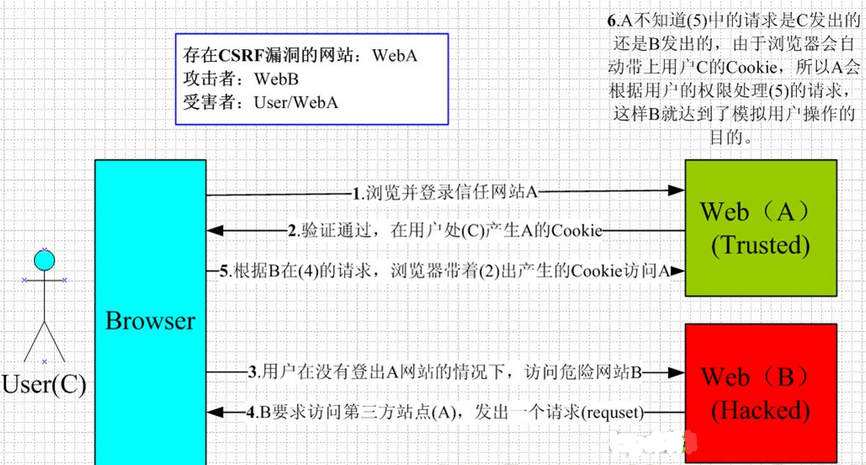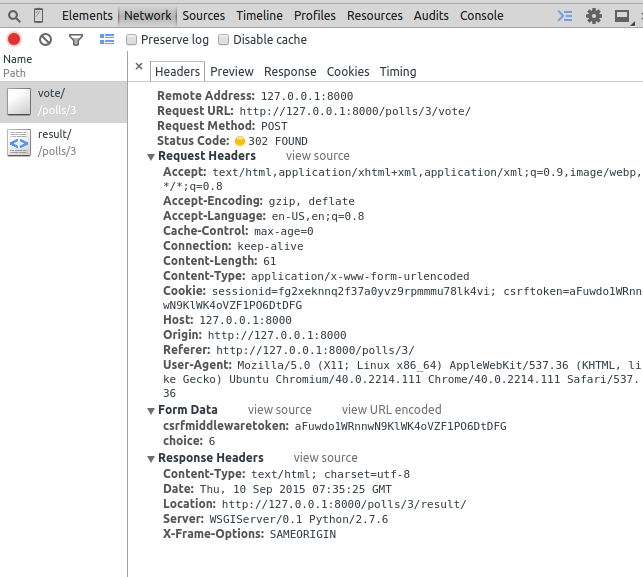为什么80%的码农都做不了架构师?>>> 
首先提一个问题:在Django中如何处理CRSF(Cross-site request forgery)?
先看一下CSRF原理。

其实就是恶意网站利用正常网站的cookie去非法请求。
##Java处理方式##
一般做法需要后台和前端配合采取策略去防止CRSF。
1 前端页面请求后台CGI的时候带上一个参数tk,这个tk是将cookie经过time33算法签名算得的一个参数。
假设cookie为"thiscookie",tk=time33("thiscookie")=fg2hgasdf;
这样在CGI上添加tk=fg2hgasdf,当然请求时还会带上"thiscookie"。所以GET请求可能是这样的
my.oschina.net/anti-csrf?name=huangyi&tk=fg2hgasdf
在Request Headers中有一个Cookie:cookie="thiscookie"
三方网站是无法获取cookie计算这个tk签名的。
2 后台程序在request中获取到cookie,也经过time33算法签名,即token=time33("thiscookie") 。然后与url中带过来的tk进行比较,如果token==tk,则认为是正常的请求。这一步通常是写在拦截器中的。
Django解决方法
Django自带CRSF的解决方法
Thankfully, you don’t have to worry too hard, because Django comes with a very easy-to-use system for protecting against it. In short, all POST forms that are targeted at internal URLs should use the {% csrf_token %} template tag。
-
django 第一次响应来自某个客户端的请求时,会在服务器端随机生成一个 token,把这个 token 放在 客户端的cookie 里。
-
客户端提交所有的 POST 表单时,必须包含一个 csrfmiddlewaretoken 字段 (只需要在模板里加一个 tag {% csrf_token %}, django 就会自动生成),每次POST请求也会带上1中的cookie。
-
服务器端在处理 POST 请求之前,Django 会验证这个请求cookie 里的 csrftoken 字段的值和提交的表单里的 csrfmiddlewaretoken 字段的值是否一样。如果一样,则表明这是一个合法的请求。
-
在所有 ajax POST 请求里,添加一个 X-CSRFTOKEN header,其值为 cookie 里的 csrftoken 的值
前端页面
<h1>{{ question.question_text }}</h1>{% if error_message %}<p><strong>{{ error_message }}</strong></p>{% endif %}<form action="{% url 'polls:vote' question.id %}" method="post">
{% csrf_token %}
{% for choice in question.choice_set.all %}<input type="radio" name="choice" id="choice{{ forloop.counter }}" value="{{ choice.id }}" /><label for="choice{{ forloop.counter }}">{{ choice.choice_text }}</label><br />
{% endfor %}
<input type="submit" value="submit to Vote" />
</form>
只需要在表单中加入{% csrf_token %}即可,作用是生成表单的csrfmiddlewaretoken字段。

在请求的头中可以看见Cookie有两个元素
Cookie:sessionid=fg2xeknnq2f37a0yvz9rpmmmu78lk4vi;
csrftoken=aFuwdo1WRnnwN9KlWK4oVZF1PO6DtDFG表单FormData中含有一个 csrfmiddlewaretoken 字段。
后台服务主要是验证cookie中的csrftoken与csrfmiddlewaretoken字段是否相等,在CsrfViewMiddleware中实现。
同时对应{% csrf_token %}模板写法,需要在views函数中加入
from django.shortcuts import render_to_response
from django.template.context_processors import csrfdef my_view(request):c = {}c.update(csrf(request))# ... view code herereturn render_to_response("a_template.html", c)
##参考
https://www.ibm.com/developerworks/cn/web/1102_niugang_csrf/
https://docs.djangoproject.com/en/1.8/ref/csrf/

)


 容我套个娃 循环)


)
)
认证 之简单实现)

自己动手写个函数)





小数组玩起来)

